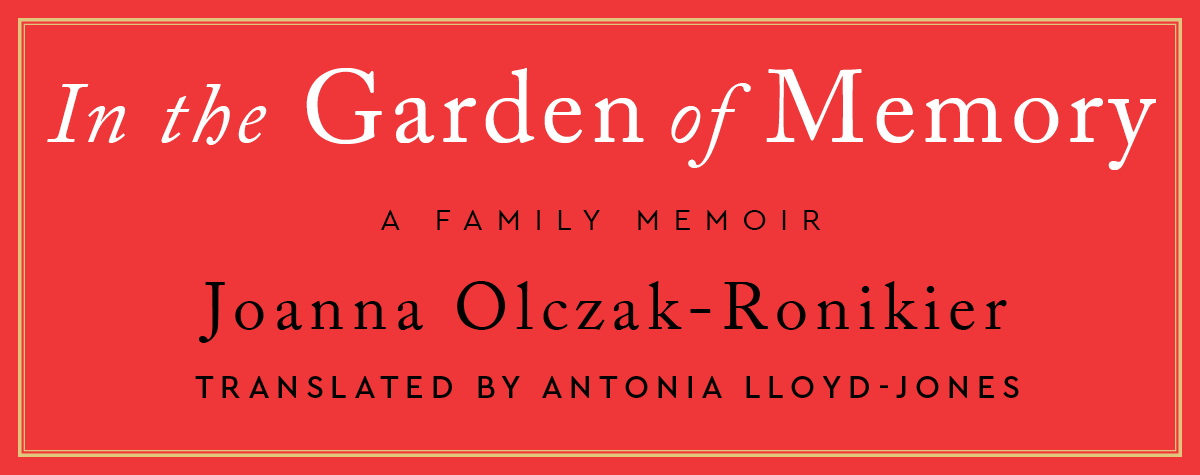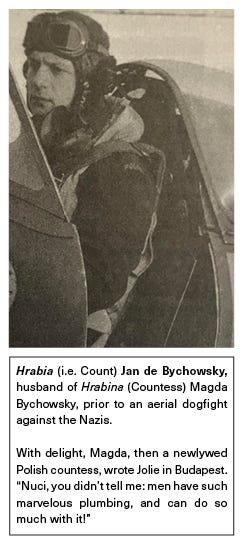"In The Garden of Memory"
Part Five: The Count of No Account
In the International Bomber Command Centre’s records, Flight Sergeant Jan Ryszard Bychowski of the RAF was killed in a crash of his Avro Lancaster aircraft on May 22, 1944. He was buried in Newark-on-Trent Cemetery, Polish Plot Grave H320B (exhumed July 29, 1974, for reburial in Hastings-on-Hudson, New York).
********************
Magda Gabor was the eldest of the three Gabor sisters, who were famous enough in their era for a 750-page book called Those Glamorous Gabors: Bombshells from Budapest, Great Courtesans of the 20th Century to be published in 2013. It was awarded the prize for Best Biography at the Hollywood Book Festival that year.
Invariably described as actresses and socialites, the sisters made nineteen trips to the altar. Magda was married six times, Eva had five husbands, and Zsa Zsa had eight. The first of Magda’s husbands was a man she called Count Jan de Bychowsky.
I was aware of the man because my mother talked about her cousin, “a shoe salesman” (with apologies to shoe salesmen, this was not a compliment) who married Magda Gabor and was renamed by her Count Jan de Bychowsky of Warsaw, which made her a countess.
There is no such inherited title that I could find in a determined search.
But in Those Glamorous Gabors, the author, Darwin Porter, writes, “The count was the scion of one of the oldest and most prestigious families in all of Poland, his pedigree stretching back to the days of the Vikings.”
After meeting Jan in London in 1937, Magda wrote to her mother, Jolie, in Budapest: “I’ve fallen in love with the Count of Warsaw. He is a divine creature, so strong, so masculine, so handsome, so intelligent…can you imagine your Magda one day presiding as the Countess of Warsaw? Oh, I forgot to mention. He is the sole owner of the Bychowsky family castle outside Warsaw.”
“When Jolie learned to her disappointment,” Porter writes, “that the Bychowsky castle had been stripped of most of its art and furnishings, she sent her daughter and her new son-in-law as a wedding present, two truckloads of antique reproductions. ‘I’ve learned that the count had a prestigious title but no money. The family fortune and its treasures had disappeared at the end of World War I.’”
Descriptions of Jan emphasize his military bearing and his skills as a fighter pilot. A grainy uncredited photograph in the book of him in full flight gear is captioned “prior to an aerial dogfight against the Nazis.”
By 1939, the book reports, “Magda found she and her husband were growing increasingly estranged. She wanted to retain her title as the Countess of Warsaw, but Jan, for nights in a row, didn’t come home…He kept telling her he was preparing his regiment for the imminent invasion of Hitler’s forces from the West.”
Three weeks before the invasion, Magda wrote to her mother that she had fallen in love with another man, a fighter pilot named Zdzislaw Henneberg. “Nuci, Nuci,” she wrote her mother, I have just learned that when I divorce Jan, I will have to surrender my title as Countess of Warsaw. Zdzislaw is a common man. He has no title. But I will make the sacrifice to be with the man I love.”
Once the war started, according to the story, Zdzislaw went to join the battle and Jan, unaware of his wife’s affair, succeeded in getting them both across the border into Romania, en route to England, where Jan said he would “fly again in a plane to fight the Nazis.”
Zdzislaw and Jan, the book relates, both joined the Poles who formed RAF units, which were legendarily gallant and successful in the Battle of Britain. (Official records list Zdzislaw as a fighter pilot who was killed in 1941.)
In a visit to Magda, Jan, who apparently had never discovered his wife’s infidelity, asked for a divorce because he was in love with a “ruddy-cheeked Devonshire girl. I call her my English Rose.”
“After packing a few possessions, he left the cottage,” Porter reported. “She never saw him again.”
In her 1975 memoir, Jolie Gabor wrote that “Magda returned to Budapest and never learned what happened to Count Bychowsky. Actually, he died in 1944 when his Hurricane was shot down over the English Channel.”
Magda’s love life progressed. In Budapest she fell in love with Dr. Carlos Garrido, Portugal’s ambassador to Hungary, and “through him,” according to the book, “Magda became a heroine of the Hungarian Underground, battling the forces of Hitler then occupying her homeland.”
Wikipedia’s biography of Magda carries this entry about her marriages:
“Jan Bychowsky (m. November 19, 1937 – May 22, 1944; his death), a reputed Polish count and RAF pilot. Gabor gave her name as “Magda de Bychowsky” and her marital status as divorced on a February 11, 1946, airline passenger manifest, accessed on ancestry.com December 30, 2011; according to this form, she had left her city of residence (Lisbon, Portugal), where she lived at 17 Buenos Aires, and arrived in New York to visit her family.”
She soon married William M. Rankin, a screenwriter, and then four more men before dying at age eighty-one in 1997 in Palm Springs, California.
Jan de Bychowsky’s life details in the available online databases always list his date of death as May 22, 1944 – the day when Jan Ryszard Bychowski was killed. I could never find any reference to Jan de Bychowsky’s military service, anywhere at any time.
Tellingly, in The Glamorous Gabors there is an italic note on page 45, where the count makes his first appearance, that says: In some news accounts, Magda was incorrectly reported to have married the similarly named Sgt. Jan Bychowski, who was a young poet who died in England on May 22, 1944, at the age of twenty-two.
Jolie Gabor, Magda’s mother, moved to New York, where she opened a jewelry shop on Madison Avenue. My mother told me that she would stop in the store occasionally and the subject of a family connection would come up.
Alas, I never pursued the saga with my mother to its logical conclusion — that the count was no count and that his death was conveniently listed as May 1944 in a plane crash.
What did happen to “Jan de Bychowsky”? He apparently kept in touch with my mother. She shared with me a letter she had from him in 1960 from Paris, where he was living, including the detail that his new apartment had an “ensuite bathroom.”
I can’t pin it down, but that may be when my mother told me the story of her cousin, “the shoe salesman.”
This is the picture and caption said to be Magda’s husband in the Gabor biography






Fascinating! You can’t this stuff up. But, apparently, Ms. Gabor did.
Enjoyed the story, Peter, an interesting footnote on history. Thanks for sharing🦋